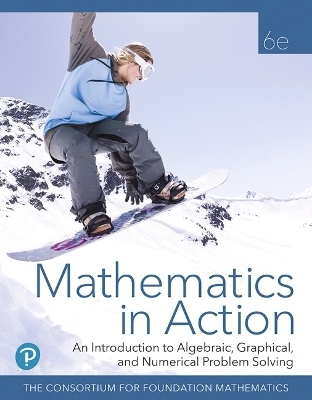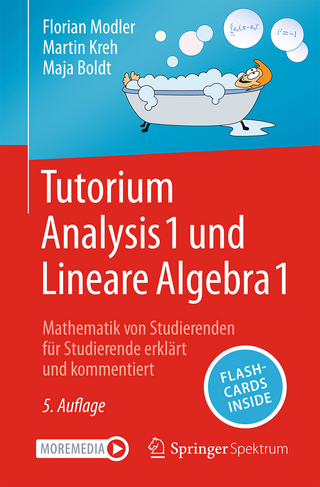
Mathematics in Action
Pearson (Verlag)
978-0-13-511562-6 (ISBN)
Active learning for active minds
The authors of the Mathematics in Action series believe that students learn mathematics best by actually doing the math within a realistic context. If a student is taking this course, why teach them the same content in the same way that they’ve already seen–yet did not retain? Following this principle, the authors provide a series of guided-discovery activities that help students to construct, reflect upon, and apply mathematical concepts, deepening their conceptual understanding as they do so. The active style of learning develops critical-thinking skills and mathematical literacy, while keeping the concepts in the context of real applications.
The 6th Edition includes updated examples and activities for maximum interest and relevance, along with new and enhanced digital resources in MyLabTM Math to support conceptual understanding for students, wherever and whenever they need it.
Also available with MyLab Math
By combining trusted author content with digital tools and a flexible platform, MyLab personalizes the learning experience and improves results for each student.
Note: You are purchasing a standalone product; MyLab Math does not come packaged with this content. Students, if interested in purchasing this title with MyLab Math, ask your instructor to confirm the correct package ISBN and Course ID. Instructors, contact your Pearson representative for more information.
If you would like to purchase both the physical text and MyLab Math, search for:
0135281555 / 9780135281550 Mathematics in Action: An Introduction to Algebraic, Graphical, and Numerical Problem Solving Plus MyLab Math with Pearson eText - Access Card Package
Package consists of:
0135115620 / 9780135115626 Mathematics in Action: An Introduction to Algebraic, Graphical, and Numerical Problem Solving
013516818X / 9780135168189 MyLab Math with Pearson eText - Standalone Access Card - for Mathematics in Action: An Introduction to Algebraic, Graphical, and Numerical Problem Solving
About our authors The Consortium for Foundation Mathematics is a group of mathematics educators, all originally from New York State, who first came together at SUNY Oswego in the summer of 1995 as part of a National Science Foundation (NSF) grant. The members of the group represented 2-year and 4-year colleges, commuter and residential colleges, large urban institutions and small rural institutions, and multi-campus as well as single-campus institutions. Unified by a desire to change the status quo to further student success, the group’s initial objectives aimed at a new approach to developmental math that included contextual problem-solving, active collaborative learning, and authentic assessment tied more closely to real-world skills. The efforts of this initial grant resulted in new instructional materials that formed the basis of Consortium’s texts, which include range from Prealgebra to Intermediate Algebra, as well as high school titles. As one Consortium author noted, contributing to this series with its different approach “changed my views about math, and about teaching math.” Of the 16 instructors originally involved in the grant, 8 instructors contribute to the latest editions of the text.
Below is an Activity-level Table of Contents for this title.
Chapter 1. Number Sense
Cluster 1: Introduction to Problem Solving
Activity 1.1 The Bookstore: Steps in Problem Solving
Activity 1.2 The Classroom: Problem-Solving Strategies
Activity 1.3 Properties of Arithmetic: Properties and Vocabulary for Arithmetic Calculations
What Have I Learned?
How Can I Practice?
Cluster 2: Problem Solving with Fractions and Decimals (Rational Numbers)
Activity 1.4 Top Chef: Operations with Fractions and Mixed Numbers
Project Activity 1.5 Course Grades and Your GPA: Problem Solving Using Fractions and Decimals
What Have I Learned?
How Can I Practice?
Cluster 3: Comparisons and Proportional Reasoning
Activity 1.6 Everything Is Relative: Ratios as Fractions, Decimals, and Percents
Activity 1.7 Antidepressant Use: Proportional Reasoning
Activity 1.8 Who Really Did Better? Actual and Relative Change, Percent Increase and Decrease
Activity 1.9 Going Shopping: Growth and Decay Factors
Activity 1.10 Take an Additional 20% Off: Consecutive Growth and Decay Factors
Activity 1.11 Fuel Economy: Rates and Unit Analysis
What Have I Learned?
How Can I Practice?
Cluster 4: Problem Solving with Signed Numbers
Activity 1.12 Celsius Thermometers: Addition and Subtraction of Integers
Activity 1.13 Shedding the Extra Pounds: Multiplication and Division of Integers
Activity 1.14 Order of Operations Revisited: Negative Exponents and Scientific Notation
What Have I Learned?
How Can I Practice?
Chapter 1 Summary
Chapter 1 Gateway Review
Chapter 2. Variable Sense
Cluster 1: Symbolic Rules and Expressions
Activity 2.1 Symbolizing Arithmetic: Formulas and Algebraic Expressions
Activity 2.2 Blood Alcohol Levels: Represent a Two-Variable Relationship Algebraically, Numerically, and Graphically
Activity 2.3 College Expenses: Symbolic Rules
Activity 2.4 Are They the Same? Equivalent Expressions and Grouping Symbols
What Have I Learned?
How Can I Practice?
Cluster 2: Solving Equations
Activity 2.5 Let’s Go Shopping: Solve an Equation Containing One Operation
Activity 2.6 Leasing a Copier: Solve an Equation Containing Two or More Operations
Activity 2.7 The Algebra of Weather: Solve a Formula for a Specified Variable
Activity 2.8 Four out of Five Dentists Prefer Crest: Proportions
What Have I Learned?
How Can I Practice?
Cluster 3: More Problem Solving Using Algebra
Activity 2.9 Do It Two Ways: Distributive Property, Greatest Common Factor, and Combining Like Terms
Activity 2.10 Decoding: Simplifying Algebraic Expressions
Activity 2.11 Comparing Energy Costs: Mathematical Models, General Strategy for Solving Linear Equations
Project Activity 2.12 Summer Job Opportunities: Problem Solving Using Linear Equations
What Have I Learned?
How Can I Practice?
Chapter 2 Summary
Chapter 2 Gateway Review
Chapter 3. Function Sense and Linear Functions
Cluster 1: Function Sense
Activity 3.1 Summer Olympics: Functions, Numerical and Graphical Representation of Functions
Activity 3.2 How Fast Did You Lose? Average Rate of Change
Project Activity 3.3 Comparing Symbolically Defined Functions and Their Graphs
Activity 3.4 Course Grade: Representing Functions Symbolically
What Have I Learned?
How Can I Practice?
Cluster 2: Introduction to Linear Functions
Activity 3.5 The Snowy Tree Cricket: Slope and Intercepts of a Line
Activity 3.6 Software Sales: Slope-Intercept Equation of a Line
Activity 3.7 Predicting Population: Problem Solving Using Slope-Intercept Equation of a Line
Activity 3.8 College Tuition: Point-Slope Equation of a Line
What Have I Learned?
How Can I Practice?
Cluster 3: Linear Regression, System, and Inequalities
Activity 3.9 Education Pays: Line of Best Fit and Regression Lines
Lab Activity 3.10 Body Parts: Problem Solving Using Regression Equations
Activity 3.11 Smartphone Plan Options: Systems of Linear Equations in Two Variables
Activity 3.12 Healthy Lifestyle: Solving a System of Linear Equations in Two Variables Using the Addition Method
Project Activity 3.13 Modeling a Business: Problem Solving Using Systems of Linear Equations in Two Variables
Activity 3.14 How Long Can You Live? Linear Inequalities
What Have I Learned?
How Can I Practice?
Chapter 3 Summary
Chapter 3 Gateway Review
Chapter 4. An Introduction to Nonlinear Problem Solving
Cluster 1: Mathematical Modeling Involving Polynomials
Activity 4.1 Fatal Crashes: Polynomials
Activity 4.2 Volume of a Storage Box: Properties of Exponents
Activity 4.3 Room for Work: Operations with Polynomials
What Have I Learned?
How Can I Practice?
Cluster 2: Problem Solving with Quadratic Equations and Functions
Activity 4.4 The Amazing Property of Gravity: Solving Quadratic Equations
Activity 4.5 What Goes Up, Comes Down: Quadratic Functions and Their Graphs
Activity 4.6 How High Did It Go? Solving Quadratic Equations by Factoring
Activity 4.7 More Ups and Downs: Solving Quadratic Equations Using the Quadratic Formula
What Have I Learned?
How Can I Practice?
Cluster 3: Other Nonlinear Functions
Activity 4.8 Inflation: Exponential Functions
Activity 4.9 A Thunderstorm: Direct Variation
Activity 4.10 Diving under Pressure, or Don‘t Hold Your Breath: Inverse Variation
Activity 4.11 Hang Time: Square Root Functions
What Have I Learned?
How Can I Practice?
Chapter 4 Summary
Chapter 4 Gateway Review
Appendices
A. Fractions
B. Decimals
C. Skills Checks
D. Algebraic Extensions
E. Getting Started with the TI-84 Plus Family of Calculators
| Erscheinungsdatum | 29.01.2019 |
|---|---|
| Sprache | englisch |
| Themenwelt | Mathematik / Informatik ► Mathematik ► Algebra |
| ISBN-10 | 0-13-511562-0 / 0135115620 |
| ISBN-13 | 978-0-13-511562-6 / 9780135115626 |
| Zustand | Neuware |
| Informationen gemäß Produktsicherheitsverordnung (GPSR) | |
| Haben Sie eine Frage zum Produkt? |
aus dem Bereich


